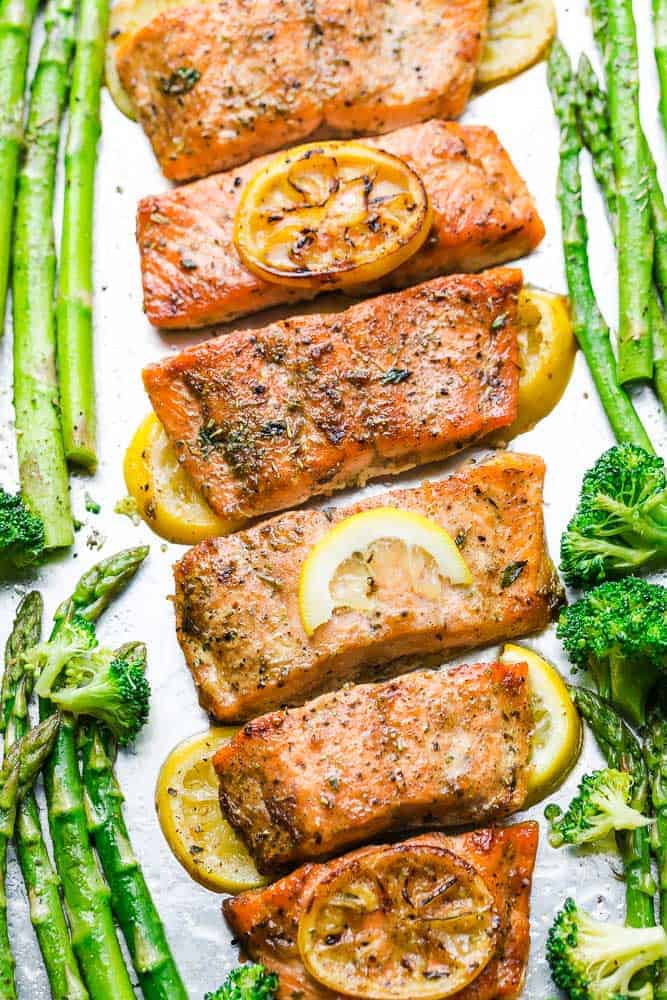This Oven-Baked Salmon is the way to go if you need an easy 20-minute recipe that produces the most tender, flaky roasted fish fillets around! Roasted to perfection and makes the perfect quick and healthy dinner. Paleo, gluten-free, low-carb/keto and Whole30 compliant.

PIN HERE for later and follow my boards for more recipe ideas
Updated June 2022
Flaky Oven-Roasted Salmon With Lemon
In a perfect world, every meal would require minimal prep and cleanup. People often turn to takeout on those busy weeknights, but a home-cooked meal is always preferable. This easy baked salmon recipe will feed an entire family in the same amount of time it takes to commute to the nearest restaurant!
It only requires one pan, and you can easily bulk it up with a built-in side dish by adding fresh veggies to the mix. It’s one of our favorite dinners and hands-down our preferred method for cooking salmon. Each moist and flaky morsel brings a burst of smoky, herby, lemony goodness.

What You’ll Need
Whether you’re keto, paleo, gluten-free or Whole30, these tender oven-baked salmon fillets are sure to earn a place in your weekly dinner rotation. It all starts with a handful of kitchen staples! The amounts are included in the recipe card below this post.
- Skin-On Salmon Fillets: Choose individual fillets that are 4-6 ounces per person. If you’re buying one large piece of fish, ask your fishmonger to portion it out for you.
- Avocado Oil: Or olive oil.
- Salt & Pepper: Added to taste.
- Smoked Paprika
- Chili Powder: No shame in omitting this if you’re sensitive to heat.
- Coconut Aminos: If you’re not on the Whole30 diet, feel free to use gluten-free tamari or low-sodium soy sauce instead.
- Lemon Juice: Freshly squeezed.
- Chopped Fresh Parsley
- Lemon Slices: For the garnish.
- Asparagus (Optional): Ends trimmed.
- Broccoli Florets (Optional)

What Kind of Salmon Should I Use?
Look for vibrant fish fillets with no added colorings to make sure they’re nice and high-quality. Either fresh or frozen salmon will work, as long as frozen fillets are defrosted before they’re used. Keep in mind that wild-caught salmon are leaner, more flavorful and less likely to be exposed to contaminants than farmed salmon.

How to Make Baked Salmon
This foolproof technique for cooking salmon only involves 5 minutes of prep time! It’s fancy enough for a date night and easy enough for a last-minute meal.
- Heat Oven & Line Pan: Preheat the oven to 400°F. Line a baking sheet with a large piece of parchment paper or heavy-duty aluminum foil.
- Season Salmon: Lay the salmon on a plate or on top of the lined baking sheet and drizzle it with oil. Season both sides with salt and pepper. Whisk together the coconut aminos, lemon juice, paprika and chili powder, then drizzle the mixture evenly over the salmon and sprinkle on half of the parsley. Fold the sides of the parchment/foil lining up to prevent any juices from leaking through (does not have to cover salmon). If you have the time, let your salmon marinate for at least 15 minutes.

- Prep Veggies (Optional): If you’re including the asparagus and broccoli florets, remove the marinating salmon from the baking sheet, re-line it with parchment or foil and add the veggies. Drizzle them with a tablespoon of oil, then add salt and pepper to taste.
- Bake Veggies (Optional): Bake the asparagus and broccoli in the preheated oven for 10 minutes. Remove the pan from the oven and move the vegetables to the side, making room for the salmon.
- Add Salmon & Return to Oven: Place the salmon in the middle of the sheet pan and slide the lemon slices underneath the fillets. Place another sheet of foil loosely over the salmon and bake for 12-16 minutes (depending on how large your fish is), or until the salmon is flaky to your desired doneness.

- Broil: Open the foil and turn the oven to broil, cooking for an additional 2-4 minutes, until the salmon is caramelized and slightly charred.
- Enjoy! Cut the salmon into sections, discard the skin if desired, then serve it immediately with more chopped parsley and a splash of lemon juice.

How Can I Tell When My Salmon is Done?
The exact roasting time depends on the size and thickness of your fish fillets. Check for doneness by sticking a fork or knife into the thickest part of the salmon. If you notice that the fish is moist and flaky with a little translucence in the middle, it should be good to go.
That being said, it’s best to check for doneness with a meat thermometer. Salmon is considered safe to eat when its internal temperature reaches 145°F. Insert your thermometer into the thickest part of each fillet to ensure they’ve all reached this temperature.
Tips for Success
Let’s talk about some simple ways to make sure your oven-baked salmon comes out flawless.
- Don’t Ditch the Skin: Remember to leave the skin intact until your salmon finishes cooking – if you’d like to remove it at all, that is. Not only does it lock in moisture while the fish bakes, but it also gets wonderfully crispy!
- Avoid Over-Baking: Over-cooked salmon is disappointingly dry, so it’s important to check for doneness as described above. Once the internal temperature of each fillet reaches 145°F, it’s time to turn the oven to broil.
- Broil It Up: While broiling your salmon is not required, we highly recommend it. That beautiful caramelization is part of what makes this dish so irresistible!

Flavor Variations
Looking for alternative ways to season your salmon? The options are pretty much endless.
- Garlic & Herb
- Taco Seasoning
- Lemon Pepper Seasoning
- Balsamic Marinade
- Teriyaki Sauce
- Cajun Seasoning
- Mango Salsa
- Italian Seasoning
What Goes With Roasted Salmon?
Oven-baked salmon tastes amazing with all sorts of different sides. In the summer, we love to pair it with a fresh Strawberry Spinach Salad. Cauliflower rice and zucchini noodles are great options year-round. If you’d like to enjoy it alongside different roasted veggies from the optional ones in this recipe, Roasted Brussels Sprouts are a fail-proof choice.

Storage and Reheating
Refrigerate cooled salmon fillets in shallow airtight containers for 3-4 days. If you included the broccoli and asparagus, refrigerate them in a separate airtight container for up to 2 days. Everything can be reheated in a 275°F oven for about 15 minutes, or until heated through.
Can I Freeze This?
While we don’t recommend freezing the optional vegetables, cooked and cooled salmon is totally freezer-friendly. Wrap each fillet in a tight layer of aluminum foil and freeze them in an airtight container for up to 4 months. Thaw out frozen salmon in the fridge overnight before you reheat it.
More Easy Seafood Recipes

This easy 20-minute recipe produces the most tender, flaky roasted fish fillets around! If you need a quick and healthy dinner, Oven-Baked Salmon is the way to go. Paleo, gluten-free, low-carb/keto and Whole30 compliant.
- 1.5 lbs salmon , or 4 salmon (4-6 ounce) fillets, skin on
- 1/2 Tablespoon avocado oil or olive oil
- 1/2 teaspoon sea salt to taste
- 1/4 teaspoon freshly cracked black pepper to taste
- 1/2 teaspoon smoked paprika
- 1/4 teaspoon chili powder , omit if sensitive to spice
- 2 Tablespoons coconut aminos , can also use gluten free tamari or low sodium soy sauce if not Whole30
- juice from 1 lemon
- 2-3 Tablespoons fresh chopped parsley divided
- lemon slices for garnish
- 1 large bunch asparagus optional, ends trimmed
- 1 cup broccoli florets optional
Preheat oven to 400°F. Line a baking sheet with a large sheet of parchment paper or heavy-duty aluminum foil. Lay salmon on top and drizzle with oil. Season with salt and pepper.
In a medium bowl, whisk together soy sauce, lemon juice, paprika and chili powder.

Drizzle evenly over salmon. Sprinkle with half of the parsley, fold parchment paper or foil sides up to prevent juices from leaking through (does not have to cover salmon). Let the salmon marinate for at least 15 minutes if you have time.
For a complete meal with vegetables (omit this step if not including vegetables), remove the marinating salmon from the baking sheet, re-line it with parchment or foil and add the veggies. Drizzle them with a tablespoon of oil, then add salt and pepper to taste. Bake in preheated oven for 10 minutes. Remove from oven and move the vegetables to the side, making room for the salmon.

Place the salmon in the middle of the sheet pan and slide lemon slices underneath the salmon. Place another sheet of foil loosely over the salmon.
Bake for 12-16 minutes (depending on how large your fish is), or until the salmon is flaky to your desired doneness but do not overcook. Open the foil and turn oven to broil - cooking for an additional 2-4 minutes, or until caramelized and slightly charred.

- Cut into sections and discard skin and serve immediately with more chopped parsley, season with more salt (if needed) and a splash of lemon juice.

- Nutrition info calculated without vegetables. With vegetables included, the macros will be 296 calories & 5 NET carbs per serving.
- To Store & Reheat: Refrigerate cooled fillets in shallow airtight containers for 3-4 days. If you included the veggies, refrigerate them in a separate airtight container for up to 2 days. Everything can be reheated in a 275°F oven for about 15 minutes, or until heated through.
- To Freeze: Wrap each fillet in a tight layer of aluminum foil and freeze them in an airtight container for up to 4 months. Thaw out frozen salmon in the fridge overnight before reheating. It's best not to freeze the roasted veggies.








 Did you try this recipe?
Did you try this recipe?






jolene -
yum, came out juicy and perfect. thanks!